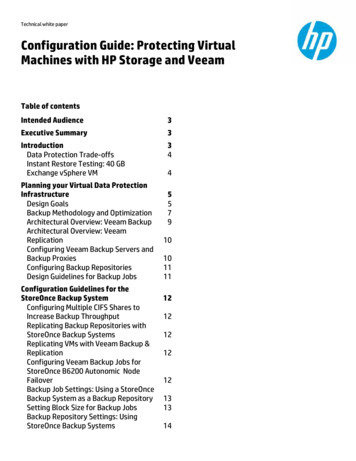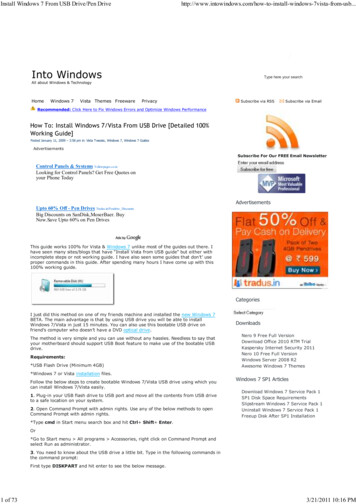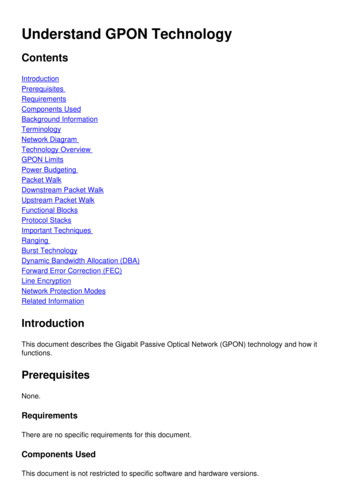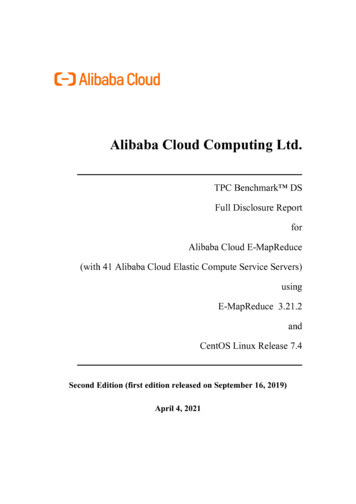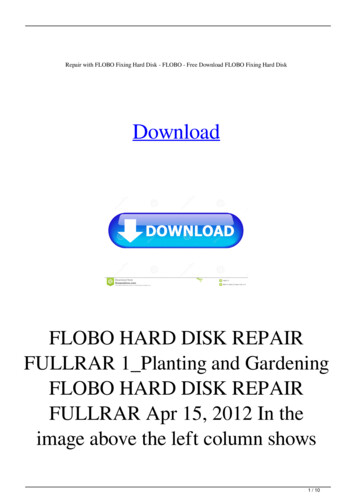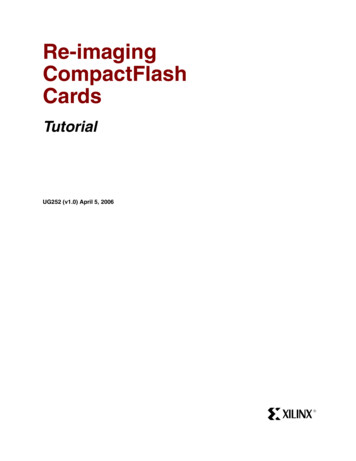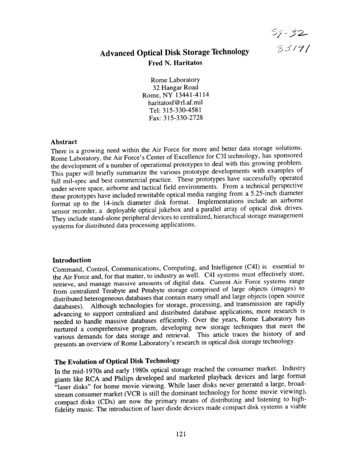
Transcription
AdvancedOpticalFredDisk StorageSJ/ /TechnologyN. HaritatosRomeLaboratory32 Hangar RoadRome, NY 13441-4114haritatosf@rl.af.milTel: 315-330-458Fax: 315-330-2728lAbstractThere is a growing need within the Air Force for more and better data storage solutions.Rome Laboratory, the Air Force's Center of Excellencefor C3I technology,has sponsoredthe developmentof a number of operational prototypes to deal with this growing problem.This paper will briefly summarizethe various prototype developmentswith examplesoffull mil-specand best commercialpractice.These prototypes have successfullyoperatedunder severe space, airborne and tactical field environments.From a technical perspectivethese prototypes have included rewritable optical media ranging from a 5.25-inchdiameterformat up to the 14-inch diameter disk format.Implementationsinclude an airbornesensor recorder,a deployable optical jukeboxand a parallel array of optical disk drives.They include stand-aloneperipheral devices to centralized, hierarchicalstorage managementsystems for distributed data , Communications,Computing,and Intelligence(C4I) is essentialtothe Air Force and, for that matter, to industry as well.C4I systems must effectivelystore,retrieve, and manage massiveamounts of digital data. Current Air Force systemsrangefrom centralizedTerabyteand Petabyte storage comprisedof large objects (images)todistributed heterogeneousdatabasesthat contain many small and large objects (open sourcedatabases).Althoughtechnologiesfor storage, processing,and transmissionare rapidlyadvancingto supportcentralizedand distributed databaseapplications,more researchisneeded to handle massivedatabasesefficiently.Over the years, Rome Laboratoryhasnurturedvariouspresentsa comprehensiveprogram,developingnew storagetechniquesdemandsfor data storage and retrieval.This article traces thean overview of Rome Laboratory'sresearch in optical disk storageThe Evolutionof OpticalIn the mid-1970sgiants like RCA"laser disks" forstream consumerthat meet thehistoryof andtechnology.Disk Technologyand early 1980s optical storage reached the consumermarket.Industryand Philips developedand marketedplaybackdevices and large formathome movie viewing.While laser disks never generateda large, broadmarket (VCR is still the dominanttechnologyfor home movie viewing),compactdisks (CDs) are nowfidelity music. The introductionthe primarymeans of distributingand listeningof laser diode devices made compact disk systems121to higha viable
consumerproduct.Laser diodes operatingwithin the near-lR.(infrared)spectrumallowed1 mm embossedpits to be easily detected.The new laser technology,in combinationwithpowerful error detecting and correctingcodes, enabled SONYand Philips to introducethefirst CD audio product a decade ago.Better optical media, more powerfullaser diodes, and very precise, low-massoptics havepropelledoptical disk technologyto a practical,powerfulsystem.The next-generationdevice introducedin the mid-1980sprovideda flexible write-once,read-many(WORM)capability.This enabled end-usersto record and playbackcomputerdata from the samedrive.The third generationoptical disk, today'srewritablesystems,offer record, playback,anderase capability.These magneto-optical(MO) disks are composedof a rare-earthalloyand transitionmaterials,which often include terbium,iron, and cobalt elements.RomeLab's current developmentactivities are concentratingin using this technologyin variousdisk format sizes.Opticaldisk storage is nvironments.RomeLaboratory'sTechnologya larger role in mass data storagefor manymilitaryapplicationsthat requirereliable operationunderharshDevelopmentProgramRome Laboratoryhas sponsoredwork since the early 1970s to exploitthe benefitsofoptical disk technology.An early prototypeused an argon laser to record and playbackdigital data from a 12.5-inchplastic-basedoptical disk.Furtherinvestmentled to thedeliveryin 1982 of a large-capacityoptical jukeboxfor satellite imagerystorageandretrieval applications.The jukeboxheld 100 write-once,read-many(WORM)disks thatprovided a [1] one Terabyte storage capacity.In the late 1980s, we transitionedour rewritableoptical storagetechniquesfrom ourlaboratoryenvironmentto the "real world."This involved building and testing a family ofhigh-performanceprototypesfor operationin workingAir Force environments.Threeadvanceddevelopmentmodels (ADMs)were built:l) a 5.25-inchdiameter,rewritableoptical disk system;jukebox.5.25-inchOpticalThe first Advancedfighter aircraft.2) a 14-inchDisk ksystemDevelopment[2] was122designedand3) deployableopticalModelto operateonboardtactical
Some of the key environmental performanceparametersincluded: high and lowtemperature,vibration, mechanicalshock, acceleration,altitude, and humidity. Therecordinghead, which moves across the disk surface to read and write, is susceptibletoshock and vibration.It usually consists of a laser diode and various optics. By moving thelaser diode and the majority of the optical componentsoff the recordinghead assembly,wewere able to reduce this mass.By reducingthe recordinghead mass,we enabled fasteraccess times and exceptionalvibrationand shock performance,ensuringreliable in-flightoperation.5.25-inchOpticalDisk SystemStorage capacity:Data transfer rates:AdvancedDevelopmentModel:Max access time:Size:300 megabytes, single-side5 megabits per second sustained10 megabits per second burst100 milliseconds (inner to outer radius)5.0 inches x 6.5 inches x 10.5 inchesWeight:16 pounds with disk cartridgeTo fully evaluatethe designrobustnessunder realisticenvironmentalconditions,weconductedan operationalflight test on board an F-16 tactical fighter aircraft at Eglin AFB,Florida, from June - July 1989. An importantAir Force milestone,it representsthe firstrewritableoptical disk systemto successfullyfly on a high-performanceaircraft usingunconstrainedflightmaneuvers.A seconddevice,providedto NASA-GoddardSpaceFlight Center and launchedon the Space Shuttle Discovery,demonstratedadvancedrobotic concepts.Informationdescribingthe robot's operationalenvironmentwas storedon the optical disk. The rewritableoptical disk contributedgreatly to the success of theNASA experiment.123
14-inchOpticalDisk SystemAdvancedDevelopmentModelThe second ADM was [3] designed to providelarger data storage capacity and fastertransfer rates. The equipmentoperated in tactical environmentsfound in larger aircraftdeployable,data processingfacilities.Digital datadouble-sidedwas recordedon a 14-inch,disk that uses a preformattedduringwrite, read, and eraseapproaches,this is the preferredconditions.rewritable,opticalspiral pilot trackoperations.Asdisk construction124dataanddisk.The larger media is ato allow continuoustrackinga result of evaluatingseveral candidatefor operationunder severe environmental
A dual-channellaser diode is used to provide faster data recordingand erasure.Each datachannel is simultaneouslyrecorded by using individuallyaddressableelementson the laserdiode array. The array is imaged through a single optical system and aligned to a commonfocal plane.In September1993, the equipmentsuccessfullycompleteda series of airborne tests on anRC-135 reconnaissanceaircraft.This demonstratedits reliabilityunder a wide range ofairborne conditions.The equipmentoperated through tactical descents,mid-air refuelings,60-degreebank turns and touch-and-golandings.No data were corruptedor lost duringthe test, and there were no hardwarefailures.The 14-inch ADM possessed the following features:Storage capacity:6 gigabytes per side (GB)Data transfer rates:25 megabits/secondsustained50 megabits/secondburstMax access time:400 millisecondsSize:17.5 inches x 23 inches x 24 inchesWeight:Deployable150 poundsOpticalJukeboxBased on past successeswith optical disk systems for space and airbornehave developed a follow-on Advanced DevelopmentModel [4].125applications,we
assdatastorageandretrievalcapabilitiesfor ticaldisksof 12gigabyleseach.Under computercontrol,individualopticaldiskscanbe located,transported,andinsertedinto the opticaldisk drivewithin 10seconds.A dualpickerroboticsmechanismenablesfastdisk accessby reducingthetime requiredto extractandinserta newdisk within thedrive.The opticaljukebox is designedto be modular for quick setup and tear-downtimes.Within 30 minutes,theequipmentcanbe disassembledandpackedinto five deploymentcases.Eachcaseis two-manportable. Equipmentassemblyis completedwithout specialtools,personnel,or training. TheequipmentwasshippedonJan 1996to Air ForceSpecialOperationsCommandfor operationalevaluation.With theendof the Cold War andthe shrinkingDoD budget,thereis a growing trendtorely moreheavilyon commercial-off-the-shelf(COTS)productsto satisfymanyof the iskTechnologyThe reliance on dual-usetechnologyhas motivatedRome kebox."Manyof the mediaand drivetechnologiesdemonstratedunder the earlier militarizedoptical disk programwill be transferredtocommercialimplementation.Under this effort, 50 rewritableoptical disks and a rewritableoptical drive will be developedand deliveredto Rome Laboratory.rewrittenalmost endlessly,thus savinglife-cyclemedia costs.double-sidedoptical disk can store 10 GB.Each optical disk can beThe 14-inch diameter,Because the optical disk drive is a modificationof a commercialWORMproduct,we'reable to leverage current WORMproductionlines.The design effort will concentrateondevelopinga multifunctionoptical drive that can access both WORM and rewritablemedia.The disk accesstimesand data transferrates will be comparableto the currentproduct.One of our objectivesis to deliver an optical disk library soffersacommercializationand lower acquisitionand maintenancecosts.commercialthat is highlypathtowardWith today'semphasison COTS solutions,this approachdevelopsa media and drivedesign that merges well with commercialproductplans.This enables both commercialand militaryintereststo benefitwhilesharingcosts126and risks,shorteningthe development
cycle and saving research and developmentfunds by leveragingan existing commercialproduct.An importantgoal is to enable the developerto incorporatethe technologyinto anext-generationcommercialstorage technology.product,thus enablingAirForceaccessto improvedmassWhen the equipmentis deliveredin 1997, the rewritablelibrary will be mated with acommercialWORMlibrary to provide a 1-Terabytestorage capability.The hybrid (0.5TB WORMand 0.5-TB erasable)optical disk library will become an integral part of medat a handling and her AdvancedInexpensiveDisksDisk OperationsDevelopment(O-RAID).Modelis our Optical127disk-basedRedundantArrayof
The purposeis to determinethe feasibilityof developinga single,integrated,highperformancedevice capable of combiningthe benefits of optical disk technologywithin aRAID system.The design is partitionedinto three basic elements:the optical disk drives,the rewritablemedia and the electronicscontroller.The basic O-RAIDdesign consists ofmultiple optical disk drives operatingas a single large optical disk to a host computerrequestingthe data.Optical disk drives are used becauseof their high reliability,dataretention capabilitiesand the ability to remove media for storage.The RAID architecturesupportsincreasedreliabilityand accuracyof the data stored.Our initial prototypedemonstrateda data transferspeed of 8.8 megabytesper second combinedwith a basestorage capacity of 6.5 gigabytesprovided by 5 parallel optical disk drives.The systemdesign is modular and scalable to take advantageof improvedoptical disk technologiesthatmay be available in the future.Next-GenerationOpticalDisk TechnologyWhile today's optical disk systems rely on laser diodes operating at 780 nm to record lgmspots, using shorter wavelengthlasers may increase disk storage.Throughoutthe world,researchersare investigatingblue-greenlaser diodes operating at 460 nm.However,tofully exploit the new laser device advantages,new media and recordingtechniques must bedeveloped.ARPAselectedRome LaboratoryasExecutiveAgent for the "ShortWavelengthOptical Storage"TechnologyReinvestmentProject (TRP).The project'sprimary goal is to develop a 20 GB 5.25-inchoptical disk by the year 2000, with accesstimes and transfer rates that are at least equivalentto magnetic disk technology.To do this,we must resolve several key issues relating to substrate materials, servo, format, masteringand substrate processes,recordinglayers and processes,and read-channel electronics.Asthe Air Force makes greater use of digital images, video, and multimedia products for theirmilitary applications,we must develop cost-effective,high-densitydata storage.Thiseffort's goal is to develop and demonstrateprototype high-density,rewritable optical disktechnology(including media, heads, and drive) and viable manufacturingtechnology.Theproject has the potential to radically alter the way informationis stored and retrieved infuture military data storage systems.SummaryOptical disk storage technologyis playing an increasinglymore important role in the AirForce's data storage and managementrequirements.Rome Laboratory'srole has been toadvance the state-of-the-artto satisfy the Air Force's unique operationalneeds throughprototype developmentand operational testing. Our needs cover environmentsfrom spaceto airborne to tactical field conditions.Additionally,optical disk technologyprovidesinherent advantagesin distributed computingenvironmentsthat require TerabyteandPetabytestorage capacities,mediumaccess times and archivability.128
However,optical disk, along with most secondarystorage devices,capacity limits imposedby its 2-D planar format.Rome Laboratorydeficienciesby investigatingalternative3-D and 4-D optical memorynew approachesare being presentedin a complementarypaper.suffersfrom storageis addressingthesetechnologies.TheseReferences[1] Haritatos,1993.[2] Haritatos,Applications,"FredN., "OpticalFredIEEE,N.,MayRecording,"High1991." DefensePerformance[3] Haritatos,Fred N., "Air Force ApplicationsSPIE/1S& T Image Storage and RetrievalSystems,[4] Haritatos,Data StorageFred N., "HighConference,Feb.Performance1991.OpticalDiskfor MilitaryFeb. 1992.Optical129Electronics,Diskvol. 25,SystemsOpticalSystems,"Diskno.for10, Sept.TacticalSystems,SPIE/OSAOptical"
Advanced Optical Disk Storage Technology Fred N. Haritatos SJ/ / Rome Laboratory 32 Hangar Road Rome, NY 13441-4114 haritatosf@rl.af.mil Tel: 315-330-458 l Fax: 315-330-2728 Abstract There is a growing need within the Air Force for more and better data storage solutions. Rome Laboratory, the Air Force's Center of Excellence for C3I technology .
